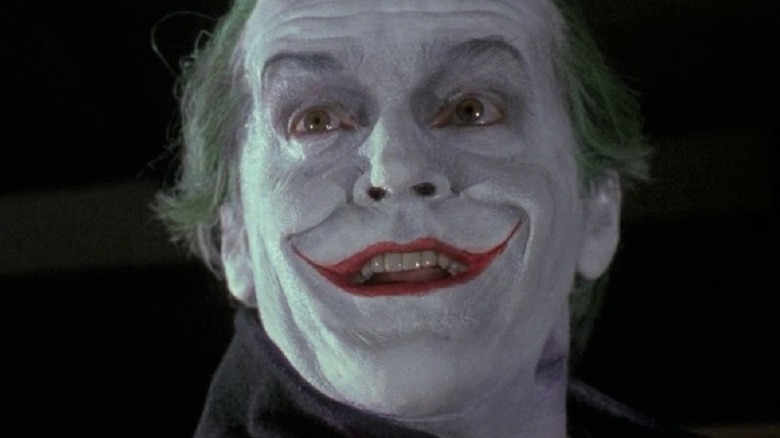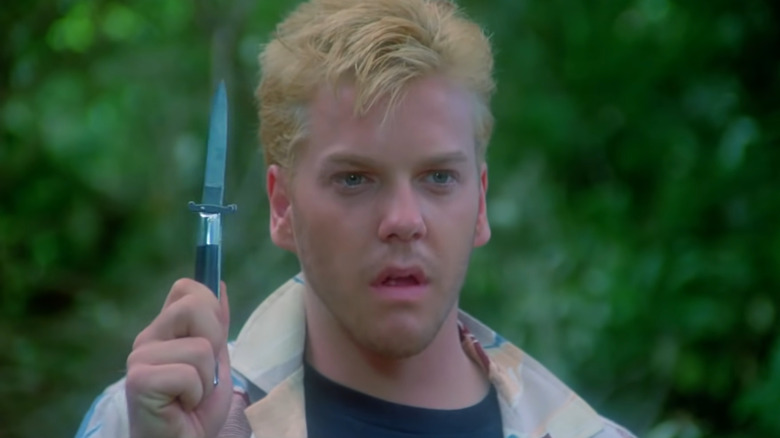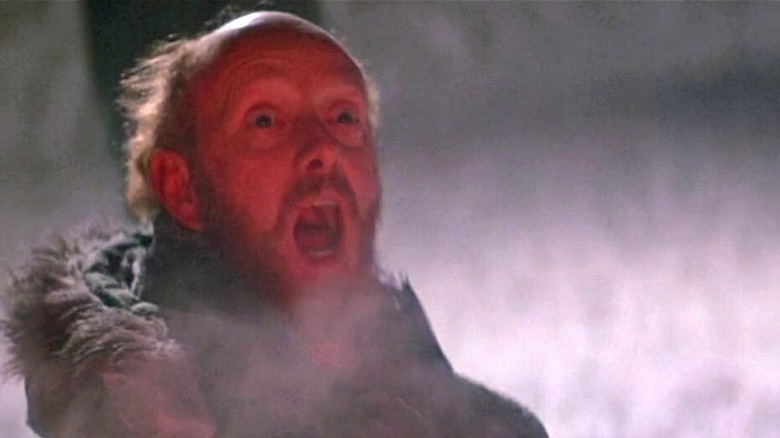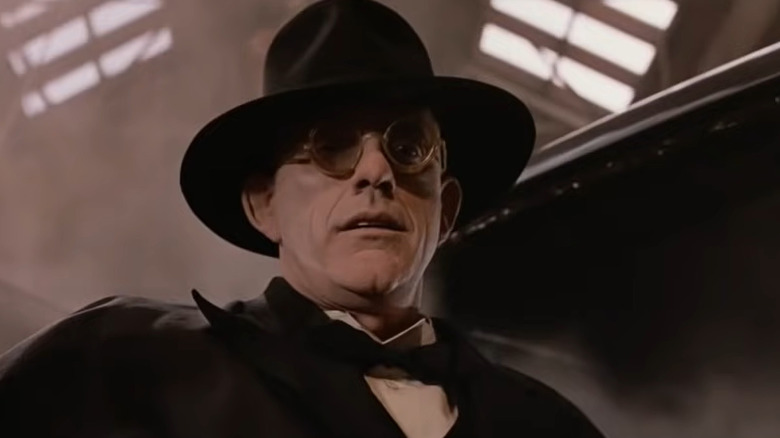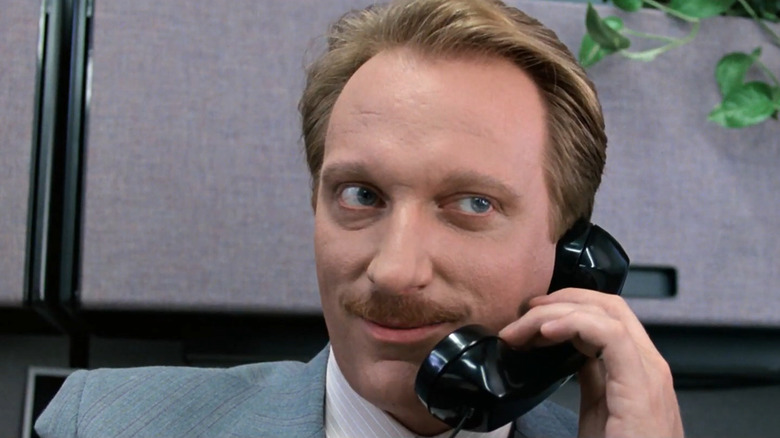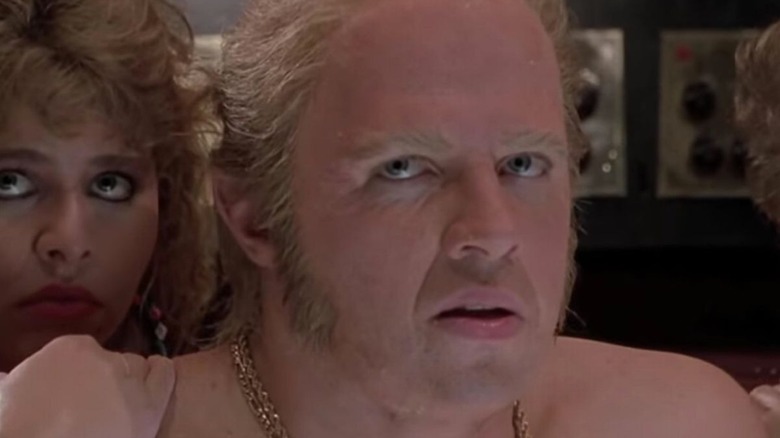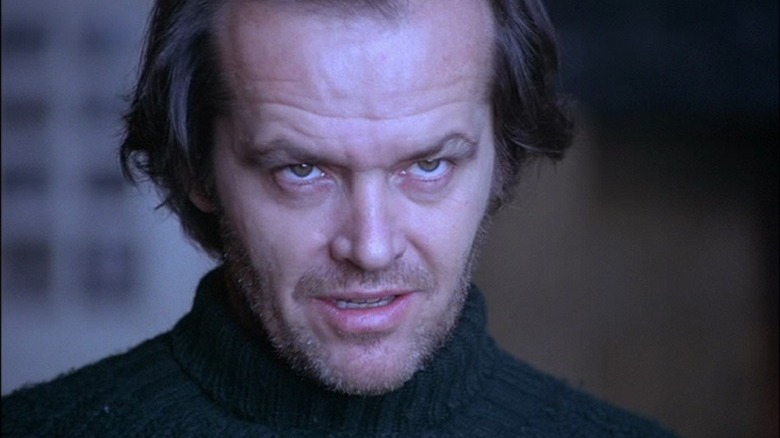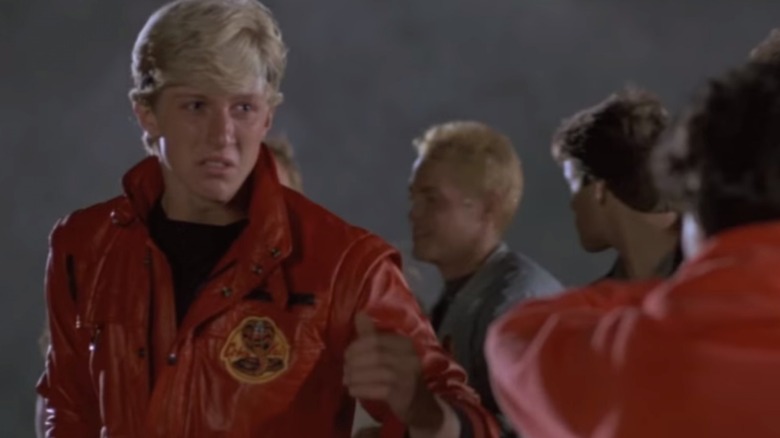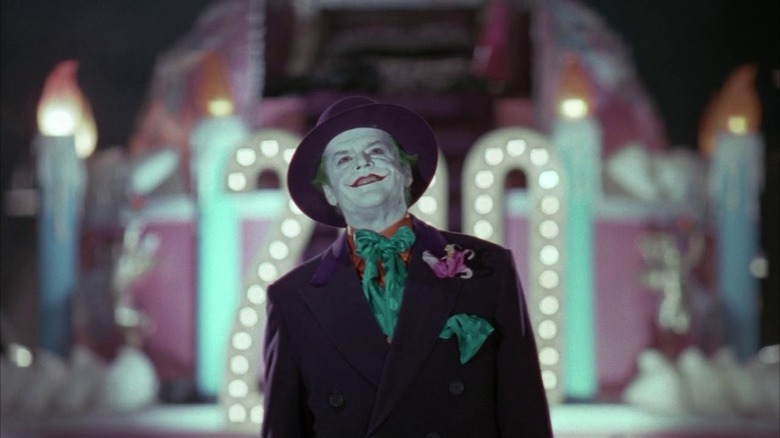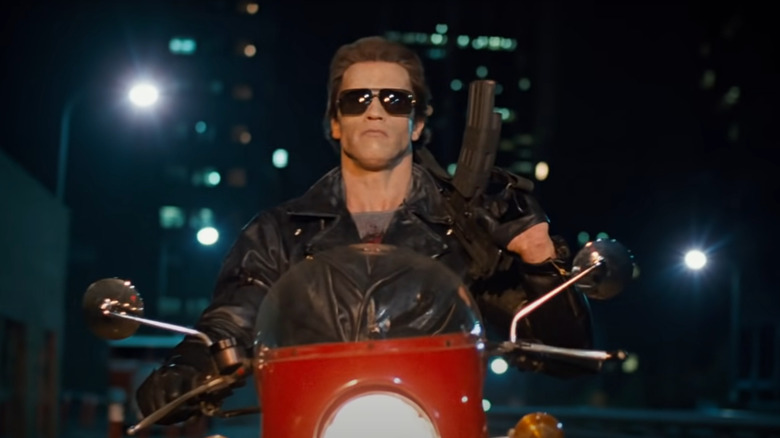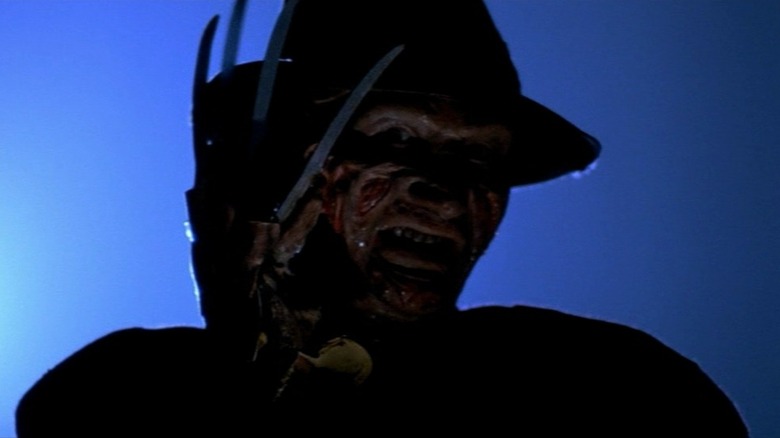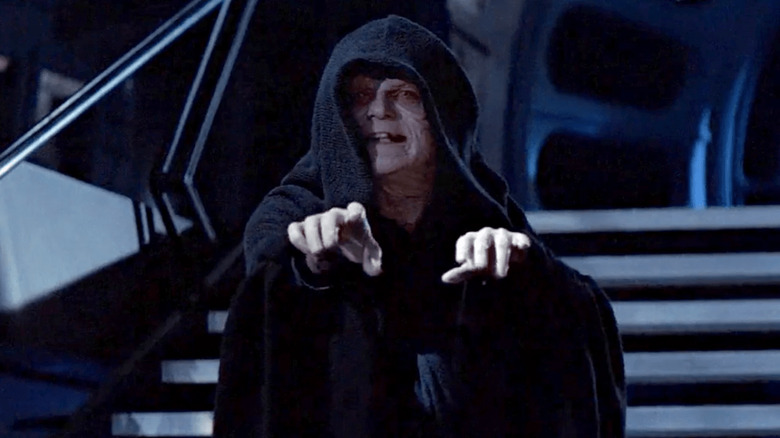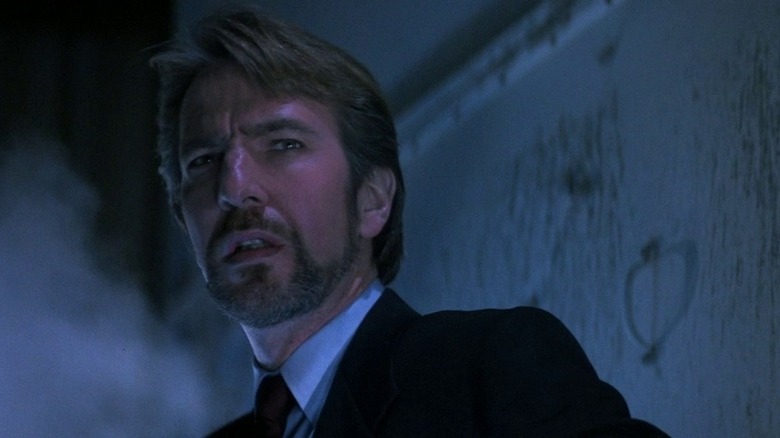Best Movie Villains Of The '80s
What's a hero without a villain? Not much. Filmmakers in the '80s knew this better than most, and they made sure to fill the decade with some of the most loathsome, dishonest, cruel, insane, terrifying, and delightfully evil baddies to ever grace the silver screen. The best of these worst are unforgettable crooks, schemers, and killers who push the hero to the edge, forcing them to evolve past their flaws to win the day. And in typical '80s movie fashion, the creeps on this list shun subtlety in favor of over-the-top, in-your-face villainy.
So which movie bad guys from one of cinematic history's most outrageous decades are the most fun to hate? We've assembled them here. These are the best '80s movie villains of all time. (We should note that to qualify, the character had to have been introduced in a film that was released between 1980 and 1989, even if they appeared after that period. Sorry, Darth Vader and Michael Myers).
Warning — spoilers ahead!
Ace Merrill - Stand by Me
To some degree, Ace Merrill from 1986's "Stand by Me" — based on "The Body" by Stephen King — is a typical King bully character. He's got a knife and a pair of oafish goons on his flanks, and he hates, hates, hates the protagonists of the story, who, like him, are searching for a dead body in the woods in the hopes of securing a reward for reporting it. He even threatens to kill the four young heroes if they try to interfere with his claiming credit for finding the corpse, but he's driven off when one of them pulls out a pistol and fires a warning shot.
Like other King bullies, Ace is sociopathically evil to the point of being absurd. Very few high school bullies, or even gang leaders (Ace is both), are quite as violent and remorselessly cruel as Stephen King seems to think they are. (And we can't imagine the worst ones are in rural Maine but whatever). However, a sharp script by Bruce Evans and Raynold Gideon and assured direction from Rob Reiner at the peak of his filmmaking powers help a young Kiefer Sutherland bring this otherwise one-dimensional character chillingly to life. Sutherland is perfectly frightening in the role and rock solid in his delivery of each sneered line, and that's more than enough.
The Thing - The Thing
Beautiful as it may be, there are two reasons Antarctica is only inhabited by researchers: It's cold, and it's isolated. Now imagine that on top of that, the place is a hunting ground for a parasitic space alien that mimics the appearance and mannerisms of whatever life forms it devours, so that its next victim won't know they're trapped in the room with it until it's too late.
Yeah, we're taking about the Thing from "The Thing." How did you guess? This unholy creation, brought nauseatingly and brilliantly to life by director John Carpenter and his team of twisted B-movie geniuses, ranks among the most hideous concepts in horror movie history. Obviously, that's why it works. But it's not just about the Thing's appearance. It's the mind games it plays on its victims, without even trying. It's ability to shapeshift and thus assume the image of its victims makes it uniquely difficult to beat, and of course, Antarctica provides few avenues of escape. The only options left are madness and death. Probably both. Definitely both.
Judge Doom - Who Framed Roger Rabbit
Get a load of this premise. When Roger, a cartoon rabbit, is accused of murder, his only hope to prove his innocence is working with a live-action private eye who hates toons. Have you ever seen a logline so outlandish? You have if you've seen "Who Framed Roger Rabbit," obviously — a movie where everything is unpredictably and delightfully absurd.
Based loosely on Gary K. Wolf's novel "Who Censured Roger Rabbit," this 1988 Robert Zemeckis film has stellar performances, timeless humor, and imagination for miles, not to mention an inventive visual blending of live-action and cartoons that remains spellbinding to this day. And one of its best features is the villainous Judge Doom.
Played by Christopher Lloyd of "Back to the Future" fame, Judge Doom, formerly known as Baron von Rotten, is a gleefully wicked toon, disguised as a human, who serves as the tyrannical and much-feared mayor of Toon Town, as well as the answer to the film's titular question. The film is so fun because it seems everyone involved had such a blast making it. Lloyd is no exception, and his scene-stealing enthusiasm spills into the audience.
Ed Rooney - Ferris Bueller's Day Off
Ferris Bueller's day off isn't the only unrealistic part of "Ferris Bueller's Day Off." Sure, Ferris, his friend Cameron, and girlfriend Sloane get into impossible hijinks while playing hooky from school. Among other things, they take Cameron's dad's car on a dangerous joyride, hijack a parade and lead the crowd in an infectiously spirited rendition of the Beatles' "Twist and Shout," and miraculously avoid getting caught by Ferris' parents, despite nearly running into them throughout Chicago on multiple occasions. So yeah, all a bit improbable, although a total blast. But Ferris isn't the only character bending reasonable expectations.
Enter Ed Rooney, school dean and the film's antagonist, who neglects work and makes it his life's mission to catch Ferris faking an illness. He leaves school, sneaks into the Buellers' home when only Ferris' sister is home, and tries to find the evidence he needs to ... give Ferris detention? Suspend him, maybe? Either way, it's far too much effort, especially since there are hundreds of other snot-nosed brats he needs to be looking after. And yet, he persists despite being knocked out, attacked by dogs, and repeatedly falling down. In the end, defeated and with his dignity and suit in tatters, he gets on a school bus and is further humiliated by more students. However, this is all part of the fun of "Ferris Bueller."
Biff Tannen - Back to the Future
You could say that Doc Brown and Marty McFly's main enemy is the clock because if they don't tie up all their time-traveling loose ends before the deadline, everything goes horribly awry (see "Back to the Future Part II"). But the one human always making their job harder than it needs to be is Biff Tannen –- a towering, dimwitted oaf who gets through life by cheating and intimidating others into doing what he wants.
In the first movie, Biff terrorizes the high school version of Marty's dad, George, until George finally gains the courage to slug him for forcing himself onto Lorraine (Marty's future mom). When Marty returns to the present, he finds a more confident version of his dad, being waited on by doting manservant Biff.
But justice is fleeting. In the second movie, Marty and Doc have to jump into action after their antics result in present-day Biff getting ahold of a sports almanac from the future, which he uses to amass an enormous sports-betting fortune and take over the town like he's Mr. Potter from "It's A Wonderful Life." In "Back to the Future Part III" (granted, a '90s movie), Biff's great-grandfather, Buford "Mad Dog" Tannen, kills Doc Brown, forcing Marty to head back to the 1800s to set things right.
Biff is the kind of character you love to hate but also love to watch. And you can thank Thomas F. Wilson's dependably hilarious performance for that.
Jack Torrance - The Shining
Based on Stephen King's terrifying novel, Stanley Kubrick's "The Shining" is a haunting, hallucinatory experience. Many creepy things await the Torrance family in the abandoned Overlook Hotel, where patriarch Jack plans to write a novel. For example, there's the man in the dog mask, the elevator filled with blood, the woman in the bath, and the girls at the end of the hall. You know the ones. "Come play with us, Danny!"
But the spirit really haunting the place is Jack himself. Played fearsomely by Jack Nicholson, Torrance is driven mad and ends the movie chasing his wife and son around the hotel with an axe. We suppose being snowed in on a far-off mountainside and getting tormented by ghosts can do that to people. But Jack started the film as a man on the edge and descended into the pit from there. So we're assuming there was already something for the demons of the Overlook Hotel — or whatever else was haunting the place — to work with once they got their claws on him.
This is all part of what makes "The Shining" work, by the way. The layers of mystery. The ambiguity. How much of Jack's insanity was him? How much was the hotel? We'll never know. But that won't stop us from rewatching the film again to see if we can figure it out.
Johnny Lawrence - The Karate Kid
One of the load-bearing beams in the structure of any '80s teen movie is the high school bully character. They're cooler, bigger, better-looking, and more popular than the protagonist, not to mention flanked by goons and dating the girl our geeky young hero is infatuated with (although she secretly thinks her boyfriend is a jerk). We've seen this story a thousand times before, but it was never better executed than in 1984's "The Karate Kid." Enter Johnny Lawrence, William Zabka's motorcycle-riding tough guy with some dangerous karate skills. When the story begins, he's more than a match for scrawny Daniel LaRusso.
And yet, there's more to Lawrence than meets the eye. He's an arrogant bully, yes, but he's also more human than your typical high school movie underachieving goon. He hasn't been held back three years, doesn't hide switchblades in his boot, and isn't constantly exasperating his teachers. And as we find out in the incredible "Cobra Kai" TV show, he's not unlike LaRusso. After all, he's just a kid from a broken home who turned to karate as a way to survive adolescence and find himself.
Even if you just want to focus on the original film itself and ignore the TV series, at the end of the movie, we learn who the real villain is — sociopathic sensei John Kreese, who manipulates Johnny and demands rule-breaking violence from his Cobra Kai boys at the All Valley Karate Tournament.
The Joker - Batman
Some actors are simply born to play a certain character. When it came time to cast the Joker in Tim Burton's "Batman," the candidates were Jack Nicholson and everyone else.
Just look at the guy. That mile-wide grin. That devilish cackle. Those eyebrows. Plus, Nicholson had already proven he could do crazy in "One Flew Over the Cuckoo's Nest" and "The Shining." He was a shoe-in. The producers did what they had to do to get him on board — even though he made them work for it — and the rest is history.
Say what you will about the movie's deviation from the source material (yes, we know the Joker didn't kill Bruce Wayne's parents in the comics, and he wasn't previously named Jack Napier), but ultimately, Nicholson was everything we hoped he'd be as the Clown Prince of Crime: silly, dangerous, unpredictable, and scary. As is now a Batman movie tradition, he stole every scene he was in, even though Michael Keaton was throwing a hundred miles an hour as his sworn enemy, Bruce Wayne, right next to him.
Later versions of the character — most notably Mark Hamill's voiceover work in "The Animated Series" and "Arkham" video games and Heath Ledger's interpretation in "The Dark Knight" — have earned just as much acclaim. But Nicholson's gangster Joker remains a performance for the ages. And "have you ever danced with the devil in the pale moonlight?" will never not be one of film history's most iconic quotes.
T-800 - The Terminator
The "Terminator" franchise might be known today for its declining quality and the almost impossibly convoluted nature of its timeline. But the 1984 original was perfectly simple. In a nutshell, a robot assassin from the future, who looks like a person, travels to the past to kill Sarah Connor, who will one day give birth to the leader of a resistance movement. Nice. Simple. Wicked cool. Oh, and when we say "assassin," you might think "ninja." But "unstoppable murder machine" might be a better term. In his defense, anyone who can shrug off shotgun blasts has no use for stealth. Plus, the quickest way into a room is by apparently punching through the wall. Why didn't we think of that?
While the Terminators in the sequels might be even more powerful than this one, nothing beats seeing Arnold Schwarzenegger in the role for the first time. He just kills and kills without breaking a sweat or changing his facial expression at all. Why would he if he feels nothing? That expressionless mug dares you to project your nightmares onto and behind it, where the iconic gunmetal skeleton and red eye of death awaits. We're not sure which face is more chilling.
Freddy Krueger - A Nightmare on Elm Street
In 1978, "Halloween" gave us Michael Meyers, a terrifying, nigh-unstoppable killer who was more force of nature than man. Then the "Friday the 13th" movies produced Jason Voorhees, a riff on that blueprint. But by the time those properties started churning out sequels, audiences were wise to the act. A killer picks off prey one by one and repeatedly cheats death. It's a formula so simple that it couldn't help but get stale just a few years in. But 1984's horror epic "A Nightmare on Elm Street" injected the genre with fresh ideas that director Wes Craven's contemporaries undoubtedly kicked themselves for not thinking of first.
In this movie, children in Springwood, Ohio, are getting murdered by Freddy Krueger, the spirit of a mutilated killer with bladed gloves, who stalks his prey in their dreams. The character doesn't only work because of his unforgettable appearance or even because actor Robert Englund infused him with more attitude than all other slasher baddies combined. He works because he operates by a well-established set of rules (he's invincible in the dream world but vulnerable if he can be pulled into this one) — which is a too-often overlooked must for horror movies -– and also because he forces his victims to forgo sleep to avoid him. That's a terrifying prospect in and of itself.
Not even a movie this inventive could avoid increasingly ludicrous and uninspired sequels. But the original, and the character himself, will never stop haunting our nightmares.
Emperor Palpatine - Return of the Jedi
First introduced as Darth Vader's boss in 1983's "Return of the Jedi," Emperor Palpatine, aka Darth Sidious, is perhaps the most supervillainy supervillain ever written. Look at him — with his yellow-eyed, ruined face shrouded in a cloak, cackling maniacally as he throws bolts of lightning from his fingertips and gleefully monologues about the joys of being hateful and cruel.
Perhaps that's why he works so well as a character all these years and movies later. Many villains are misguided or desperate. Some have a point; others have sympathetic backstories that explain their dastardly ways. Even Palpatine's star apprentice, Anakin Skywalker, had to be traumatized and manipulated into joining the Dark Side.
But as far as we can tell, Palpatine is evil because he loves being evil and for no other reason. Whether he's starting wars and scheming against democracy to amass dictatorial powers, seducing potential pupils and then betraying them to their face the split second a better student presents themselves, or ruling the galaxy with an iron fist, this tyrant finds more joy in his wicked work than anyone else in the saga. And you know what? That kind of enthusiasm is infectious.
The character does overstay his welcome a bit in 2019's "The Rise of Skywalker." But that's hardly the fault of longtime Palpatine actor Ian McDiarmid, who brings bottomless gravitas and enthusiasm to the role whenever he gets a chance to play the iconic Sith Lord.
Hans Gruber - Die Hard
Christmas movie or not, we can all agree that 1988's "Die Hard" is one of the finest action thrillers to ever grace theaters. It's got explosive shootouts, sharp writing, grounded stakes, funny and quotable one-liners, and an iconic hero in Bruce Willis' John McClane — the quintessential insubordinate cop who gets results.
But the movie's crown jewel is Hans Gruber. Cold, calculating, brilliant, and eloquent with a temper, Alan Rickman's performance as the German master thief, who holds the residents of Nakatomi Tower hostage, is simply oozing with an irresistibly classy flavor of evil. Always the smartest man in the room, Gruber works as well as he does because he thinks like a hero. That's not to say he is one, but rather, the clever way he improvises, outsmarts his enemies, engages in dialogue to resolve disputes when he can, and uses the environment to his advantage is usually reserved by writers for protagonists.
Therefore, Gruber deserves to spend most of the film this far ahead of McClane, who's punished for every mistake and forced to swallow his pride, acknowledge his flaws, evolve, and push himself beyond his limits to win. Gruber brings out the best in the hero, which is exactly what a great villain should do. So take note, screenwriters. Decades after "Die Hard," Gruber remains the gold standard against which all action movie baddies are measured.
